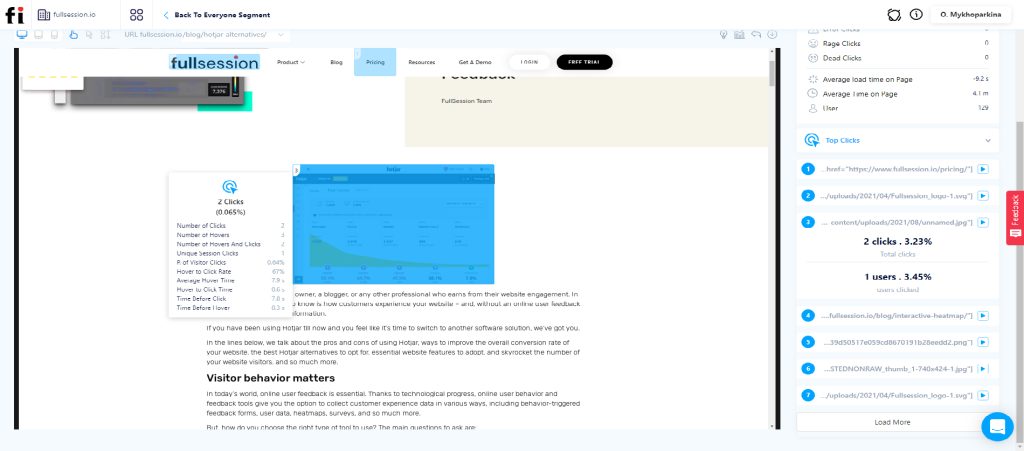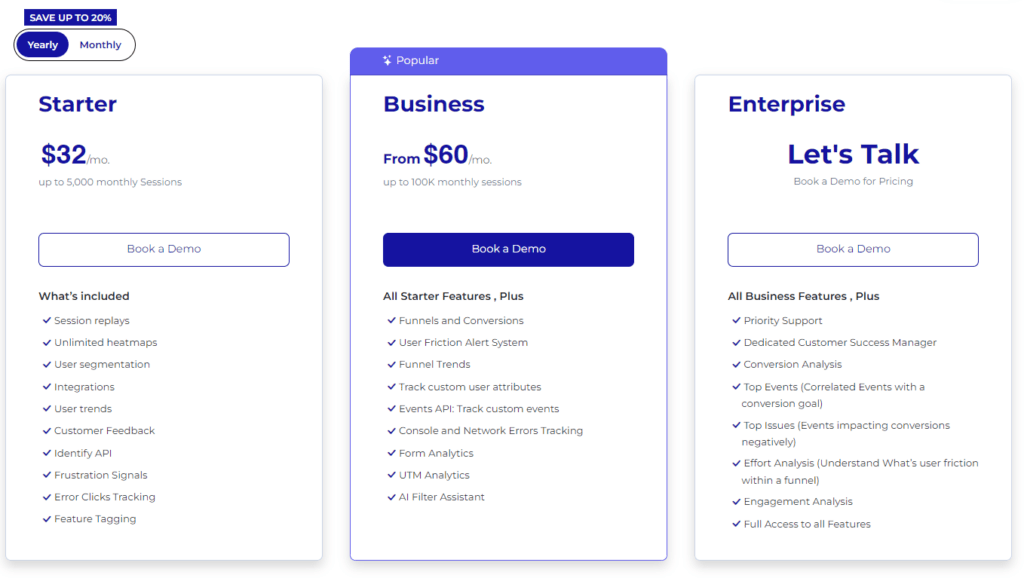FullSession vs. Hotjar Heatmaps: Which Wins for SaaS? ...

Top 9 Website Optimization Strategies: The Complete 2025 Guide
Creating a superb product or service is something we all like, but 89% of consumers will go to your competitor after a poor user experience. And this is where good website optimization strategies come to the scene. They can help you outrank your direct rivals, and grab a bigger market share. Which we all fight for, right?
In this article, we will show you some of the best strategies and optimization techniques that can help you rank higher in search engines, and more importantly—build a solid website that will be ready to deliver.
What is Website Optimization?
Website optimization, or as industry professionals know it, Search Engine Optimization (SEO), is the process of improving a website to increase its visibility when people search for products or services that are related to the business in search engines like Google, Bing, etc.
If you want to optimize your website, you need to apply multiple techniques, as Google Search Console takes multiple factors into the picture:
- Site speed
- Website content quality
- Mobile compatibility
- Website organization, etc.
The more boxes you tick, the better your user experience will be.
What Are The Goals of Website Optimization?
Website optimization, after all, wants to optimize the website resources and achieve the full potential of the product or service. But what are the main targets?
- Increase the web traffic
- Improve the user experience
- Boost the conversion rates
- Build more brand visibility and awareness
- Achieve a better ROI (Return-on-Investment).
9 Best Website Optimization Strategies

Website optimization strategies are crucial if you want to improve user experience and achieve your business goals. They are the difference between a successful business and a promising one that hasn't lived up to expectations. Let's see the 10 crucial website optimization strategies that can make or break your website.
1. Incorporate Mobile-First Design
With over half of global web traffic coming from mobile devices, a responsive design isn't just smart. It's essential. Such a strategy means designing your site for smaller screens first and then scaling up. The payoff? A much better user experience could help keep those ever-impatient mobile users engaged.
The key is simplicity and speed. Think big buttons, responsive layouts, minimalistic menus, and lightning-fast load times. Google loves this approach, too, because it aligns with their focus on mobile-first experience—so much so that they've made mobile-friendliness a ranking factor.
2. Optimize Content to the Best On-Page SEO Practices
You can have the sleekest website around, but without solid content marketing in place, you might as well be winking in the dark—the right people just won't find you. Let's see some of the best SEO practices you may have to apply:
- Focus on creating high-quality, informative, and engaging content. Your content should provide real value to your audience and answer their questions, needs, and interests. Well-researched, original, and relevant content is more likely to attract more readers.
- Try to answer search intent. You don't need SEO tools to see it. Just use Google or a SERP API to get these insights.
- Identify and target the right keywords that your audience is searching for. Use these keywords strategically in your content - in titles, headings, the body of the text, and meta descriptions.
- Organize your content using header tags (H1, H2, H3, etc.). It helps search engines understand the structure and key points of your content.
- Include relevant images, videos, infographics, and other multimedia elements. These can help explain complex topics, break up text, and engage users.
- Regularly update your content to keep it current and relevant. It is especially important for topics that change frequently.
3. Spend Some Time on Technical SEO
Technical SEO is the part that is related to how well the site is structured. It is crucial for improving a website's structure and ensuring it's easily navigable by both users and search engines. Some of the aspects of the strategy focus on:
- Improving site structure for better crawlability and indexing by Google.
- Correct technical errors and broken links.
- Make sure the robots.txt file is accurately guiding search engine crawlers.
- Use Google Search Console to monitor site indexing and address any issues.
- Conduct content audits to find and improve or remove underperforming content.
- Do not forget about the core web vitals, as they can significantly boost your visibility.
4. Improve User Experience (UX)
The user experience analysis is among the most common website optimization strategies. Why? When UX hits sweet spot levels after optimization, you can see bounce rates drop by a lot while time spent on a page goes up significantly.
Websites optimized for UX don’t just look good—they feel good too. They anticipate user needs before even users do it themselves. And let us tell you, when someone finds using your site easier than snapping their fingers, they’re bound to come back for more.
5. Improve Page Load Speed
Website speed is among the ranking factors which often gets underestimated. Site speed can sometimes be a deciding factor for user retention and engagement. A faster loading site improves user experience and is favored in search engine rankings.
Some key strategies to improve page load speed include (but are not limited to) optimizing image sizes, leveraging browser caching, minifying CSS, JavaScript, and HTML files, using a content delivery network (CDN), and ensuring efficient server response times.
6. Optimize Images and Videos
A huge part of the optimization process is related to media files, albeit some web admins and SEOs don't take full advantage of it. You should compress images without compromising quality, and you can easily do so with online tools like TinyPNG or ImageCompressor.
Use the appropriate file formats (JPEG, PNG, etc.) and implement lazy loading for images to load only when they come into the user's viewport.
7. Analyze Your Performance and Monitor Progress
Knowing if optimization practices work is, without a doubt, paramount for your website's success. Analyzing performance and monitoring progress is essential in website optimization, as you can see if there are any website issues.
You can use tools like Google Analytics and Google Search Console to track website performance with key metrics such as traffic, bounce rate, conversion rate, and page load times.
8. Include Link Building
Link building is an effective optimization strategy, as it helps Google understand that you are a trustworthy source. When other credible sources cite or link back to your website, it signals authority and boosts your search rankings.
Using a link building agency can be beneficial too, to save you time and effort. For example, if you own a SaaS, you can partner with a SaaS link building agency to acquire you backlinks on autopilot.
It can also elevate your average position in search results, ultimately driving more traffic to your site. Some of the ways you can get more external links is to create content that is helpful for your website visitors and build relationships with other industry members so you get valuable mentions.
9. Test, Test, Test
No matter what you do, you can't really bring more website users, if you don't know what works, and what doesn't. A/B and multivariate tests can offer some great benefits that can help you rank higher.
Both testing methods can significantly boost site performance. A/B testing is ideal for gaining clear insights into single changes, while multivariate testing is best for optimizing multiple aspects of a page simultaneously. But the latter is a bit more complicated, so have that in mind.
What Are the Benefits of Optimizing Your Website?
The benefits of website optimization will impact the functionality of your site and contribute to your brand’s image and online visibility. Here are some of the key benefits you’ll gain:
- Better user experience: Website optimization strategies lead to better page loading speed and responsiveness. A user-friendly interface encourages visitors to engage for longer and interact with you content more.
- Improved traffic: Once your website is at the top of search results, it will get increased traffic. The more people visit it and interact with it, the longer it will remain at the top position.
- Increased conversion rates: A well-optimized website will positively impact conversion rates. This will ensure higher conversion rates, whether it’s sales, sign-ups, or other actions.
- Positive impact on brand image: A fast, user-friendly, and technically sound website will have a positive impact on your brand image. Visitors usually associate a well-optimized site with professionalism and trustworthiness.
- Analytics-driven decision-making: Optimization also involves constant monitoring and analysis of website performance metrics. When you use analytics tools, you gain insights into user behavior, preferences, and trends. It also allows you to easily identify areas for future improvements.
How Can FullSession Help With The Optimization Process?

If you want your business to succeed, you need to know your target audience very well. It means being aware of every action they take on your website. Knowing your customers’ behavior will help you understand what they want. Where did they click and why?
FullSession offers useful features that can help you track this. Let’s take a look at how they work.
1. Session Recordings
The session recording tool allows you to get a detailed overview of your customers’ behavior on your website. It captures the real-time journey of your customers as they navigate through your website by recording mouse movements, clicks, and interactions.
This tool will help you find pain points and areas of interest. You can also spot and fix any usability issues, technical glitches, or other challenges they may encounter during their visit.
2. Interactive Heatmaps
Interactive heatmaps can help you visualize user engagement patterns by highlighting areas of high and low activity on your website. They can be applied to pages and specific elements or forms.
The main benefit of website heatmap tools is that you can see which sections of your website are receiving the most attention. Use this data to optimize your content, calls-to-action and any visual elements.
3. Funnel Optimization
Funnel optimization keeps an eye on how users move through certain paths on your website, like buying something or filling out a form. This tool lets you see where users stop and leave the website. Then you can make those paths better so more people finish what they came to do.
This way, you can base your website optimization strategies on concrete data rather than assumptions. Once you know which areas to optimize, it will lead to higher conversion rates.
Optimize Your Website With FullSession
It takes less than 5 minutes to get your website optimization tools, with FullSession, and it's completely free!
FullSession Pricing Plans

Here are more details on each plan.
- The Starter plan costs $39/month or $32/year and allows you to monitor up to 5,000 monthly sessions with up to 6 months of data storage.
- The Business plan costs $75/month or $60/year and helps you to track and analyze up to 100,000 monthly sessions with up to 12 months of data storage.
- The Enterprise plan has custom pricing and offers customizable sessions plus full access to all features.
Conclusion
Now you've got the lowdown on website optimization strategies. You know what they are, why they matter, and how to use them. Remember this: faster load times keep users happy. A sleek design turns heads. Solid SEO gets you found. And analytics? They're your roadmap to success.
Tune in to FullSession for even more insight into refining your site's performance. Make it a magnet for both new visitors and loyal customers alike.
FAQs in Relation To Website Optimization Strategies
How do you optimize a website?
To tune up your site, focus on loading times, mobile-friendliness, SEO practices, quality content, and strong call-to-actions. It's all about the user journey.
What are some techniques for improving website performance?
You can boost your site speed if you compress images, minimize code bloat, and ditch unnecessary plugins.
What is website performance optimization?
Website performance optimization is a process that wants to improve the site's speed, efficiency, and usability to improve user experience, increase engagement, and boost search engine rankings.
What are website optimization strategies?
Website optimization strategies are strategies that aim to improve the general website health, rank it higher in search engines (like Google), and bring more traffic.